1905-06
- More records broken in the league
- Record crowd watches a Scottish Cup tie at Meadowside
- Top 5 league finish
Since winning promotion from the Second Division in 1902 Partick Thistle had consistently been improving their league positions in the top league, from 8th in 1903, to 7th in 1904 and then 6th in 1905 (which had been their highest finish since the league began). Could more improvements be made in 1905-06?
It would be a difficult proposition. Resources were limited at Meadowside and new players couldn’t be obtained as quickly as some clubs. Celtic and Rangers already had a huge advantage over other clubs with the big crowds they attracted, while in Edinburgh Hearts and Hibs also pulled big crowds. Closer to home Third Lanark were Glasgow’s third team based on their performances over the past few years.
The Evening Times, however, saw potential alongside improvements at Meadowside and felt that this could be the season when Thistle became one of the top teams in Scotland.
The season previewed
“The Partick Thistle team will not differ very much from last season, and the executive are looking forward to again taking a prominent place in Scottish football. Last season the Thistle may be said to have entered a new era, and never in the history of the club has such distinction been achieved. After struggling for years as second-raters the Thistle has worthily earned a position among the half-dozen first-class clubs in Scotland, and it will not be the fault of the present management if this high standard is not maintained.
In addition to their successful cup tie career they had quite a phenomenal run of victories in the Scottish League, extending over two months, which exercised ambitious dreams in the Meadowside camp. But it was not to be. The team seemed to lose heart when defeat called, and their ultimate total of 26 points was not as good as their earlier form presaged.
In the Charity ties the team again recovered , and their decisive victory over the Rangers in the opening round will not readily be forgotten down Partick way. This they endorsed by their ultimate victory over Third Lanark, but the strain was too much, and they fell to the Celtic in the final, the same club having blighted the hopes of the Thistle in the Scottish and Glasgow Cup ties. All round had Partick’s rise to power with satisfaction.
It is good for Glasgow that her clubs should be of as equal standard as possible, and the Thistle management are determined to make the old club a power in present-day football and worthy of the large constituency from which they derive their support. That the public will respond is evidenced by the sum drawn when the Hibernians opposed the Thistle in their undecided Scottish tie on 4th February last, the figures, which constitute a record for Meadowside being – Gate £379; stand £36.
Coming to the team, it may at once be said that there will not be many changes. All the desirable players of last season have been retained, and only two new men have been signed on during the close season, these being Swan, late of Tottenham Hotspur and St Mirren, and Brown, a junior from Newmilns. Towards the end of last season the want of a reserve back was severley felt, and, in addition to Harvey and Gilchrist, McKenzie has been signed. McKenzie hails from Bo’ness and on trial gave entire satisfaction. No change is made in the half-back division, which proved the backbone of the team last year. With regard to the forwards, it is here a little planning and fixing will have to be done. Swan, who comes with good credentials, has a local connection, having played as a junior in Partick. He is available for either inside positions or centre. The left wing forwards are in the majority, but such as R.Gray can easily adapt himself to another position, and, in addition, the club has one of those handy players in W.Gray, who can substitute a half-back or a forward, as was seen last season.
The following is the list of professionals signed on up to date:- Goal – Howden; backs – Harvey, Gilchrist and McKenzie (Bo’ness); half-backs – Gibson, Melville, Walker, Harry Wilson, and W.Gray; forwards – Sommen, Kennedy, R.Gray, Lawrie (Clydebank Juniors), McGregor (Crieff), Swan (Tottenham), and Brown (Newmilns). The Thistle will also have the assistance of W.W.Tennant, the popular amateur, who can adapt himself to any position in the front line, and Carrick Hamilton, late of Queen’s Park, also an amateur, who will be early be seen at outside left. The departures from Meadowside are:- J.Wilkie, to Hibernians, and Massey, to Port Glasgow Athletic, while T.Wilkie, goalkeeper, and A.Wilson, back, have retired.
Training started on 25th ult., the players being again under the care of John Nutt. The ground is in beautiful order, the playing pitch having received special attention. Everything considered, the Thistle are well equipped for the work before them, and with such a popular chairman of directors as Mr W.Ward and capable manager as Mr Easton, assisted by an enthusiastic directorate, this season bids fair to eclipse the doings of last. The opening match is with St Mirren at Meadowside on the 15th, and on Saturday the 19th the Thistle commence their League matches by playing Aberdeen (away).”
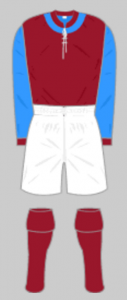
New kit for 1905-06
No sooner had the Times printed their preview than it was out of date. William Tennent, who had played the previous season as an amateur, moved to Queen’s Park. George Gilchrist was suspended for a month after he played in three Charity Cup matches at the end of the previous season without being a registered player, and his absence allowed Archie McKenzie, newly signed from Bo’ness after a few matches on trial the previous season, to begin developing a full back partnership with Tom Harvey. Early suggestions in the press suggested Thistle might be stronger than the previous season.
Bob Campbell, who had moved to Ibrox half-way through the previous season, had joined Millwall.
George Easton had been appointed as the club’s first manager by President Wilton, but the position wasn’t yet one that selected the team. Rather Easton managed the club on a day-to-day basis. One of his changes was a new strip. The black and gold stripes had been replaced by a claret-coloured jersey with pale blue sleeves and collar, similar to the one worn by Aston Villa.
The season begins
Aberdeen had been elected to the division, having been formed in 1903 as a result of the amalgamation of three clubs from the city, and for their first First Division match they welcomed Thistle to Pittodrie. Hopes were high and there was great excitement in Aberdeen for the game. 7000 spectators watched the game and were frustrated as Harvey and McKenzie frustrated every home attack. Sam Kennedy was in good form and he scored the only goal of the game with a powerful 30 yard shot.
Thistle were known for helping good causes, often playing benefit matches for individuals and charities, and early in the season they welcomed Port Glasgow Athletic to Meadowside for a fundraising match for the St Vincent (Sandyford) Masonic Lodge, and then Queen’s Park to play a match to benefit local amateur team Rockbank.
The next league game was to begin a pattern in games that was to frustrate players and fans alike. Thistle dominated the first half against Third Lanark. The forwards, with a good close passing and dribbling game, simply walked around the 3rds defenders as if they weren’t there. The Daily Record commented that “If Partick Thistle keep up that form very few teams will be able to beat them”. However, Thistle couldn’t take their chances and the visitors won the game 2-1. Carrick Hamilton was the outstanding forward on the field and he scored Thistle’s goal.
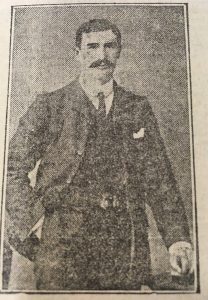
Sam Kennedy
After a 2-0 win in the first home match, against Falkirk, Thistle travelled to Dundee. Sam Kennedy was quoted before the game as saying “Dundee had a better team last year than they have this year, and we beat them with a team which is inferior to the eleven we have this year.” Sam predicted a Thistle win but the game was perhaps more difficult than anticipated and the game ended 1-1 after James Sommen scored. Dundee were a bit unlucky, having a player sent off, unfairly suggested the newspaper reports, and a goal disallowed incorrectly for offside. Sam Kennedy believed the Dundee goal should have stood: “All the same, we threw away the game after having run them so hard in the opening stages of the game.” The Thistle defence caught the eye, with backs and half backs working well together rather than as separate units.
In the Glasgow Cup Celtic had often been the obstacle Thistle couldn’t get over, and with recent form there was hope that, this time, Thistle would beat their rivals and have a good Glasgow Cup run. “The Thistle might for once get a glimpse of the turn in the long lane in which they have been so hopelessly travelling during the past few years.”
On the contrary, with the worst performance of the season so far, Thistle never came close to matching Celtic, and could do little right, losing 0-4. According to Willie Howden “it was the worst game we have ever played”. President William Ward reckoned the score could have been double figures if it hadn’t been for Howden’s performance. “Our boys have gone a bit off colour just now but we’ll come again, of that there is no doubt,” reckoned Ward after the game.
Tinkering with the team
Ward and the directors’ response was to make changes in the team, trying to find a consistent lineup. George Gilchrist replaced Archie McKenzie at left back, while Neil Gibson returned after injury, and a 1-0 win was recorded over Hibs, but changes were again made against Morton as the forwards’ performances still weren’t satisfactory. Adam McCall and David Walker had been playing well for the reserves (as had Gilchrist), and they were promoted to the first team. Andy Swan replaced Kennedy at centre forward. It was a rest for Sam (the most travelled player in the league). – he lived in Girvan and travelled 62 miles by train each way to get the Glasgow every week. Both Swan and McCall scored in a narrow 2-1 win. “We were lucky to win for in the second half the Morton played a really good game; in fact my fingers have not been kept so warm for some time,” explained Willie Howden after the game. Howden had been in great form since the start of the season.
Further changes were made for the visit to Tynecastle to play the league leaders. Neil Gibson was moved to outside right, an unusual position for a player approaching the veteran stage. Sam Kennedy came back in at centre forward. Willie Howden gave his thoughts before the game. “If our forwards play as they did at the beginning of the season we can give the Hearts a good game. If we can beat [Charlie] Thomson, who, in my opinion, is the greatest half-back in Scotland, we will beat Hearts.” It was a tough ask. Hearts were on a four game winning run, while Thistle had been (at best) inconsistent. It was no real surprise that Hearts won 2-0.
The Daily Record was concerned about the form of the team. “This time last year Partick Thistle went on a good run. However, there’s no sign of that happening this year. The backs are playing well and have lost just eight goals in eight games. Forward problems bulk largely down Meadowside way.”
On the contrary, though, Thistle did post a series of better results between the Hearts game and the first game of 1906. 6 wins, 2 draws and a single defeat (to Celtic again). “The Thistle have seldom done well against Celtic in the League so that they take their annual whacking philosophically,” reported Athletic News.
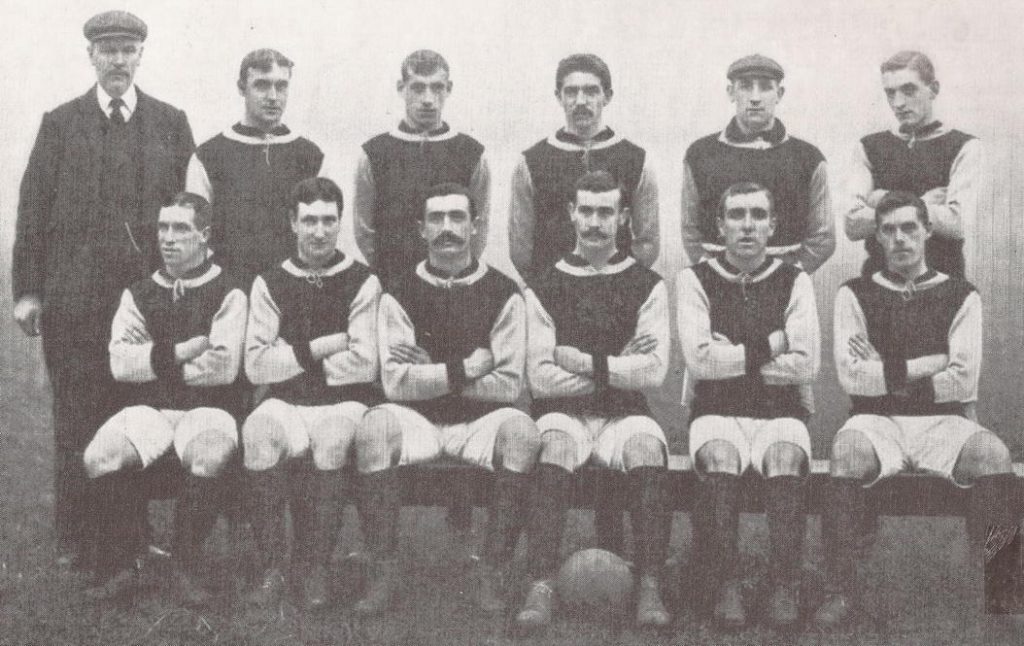
Partick Thistle, lined up against Celtic 4 November 1905
Back row (left to right): John Nutt (Trainer), Andrew Swan, David Melville, Carrick Hamilton, Willie Howden, George Gilchrist.
Front row: James Sommen, Harry Wilson, Sam Kennedy, Tom Harvey, David Walker, Robert Gray.
The performances, however, were unremarkable. While the defence had lost the fewest goals in the league so far (apart from leaders Celtic and Hearts) they had also scored the fewest (apart from Hibs). What was missing was a centre forward “capable of uniting the forwards and seizing opportunities at goal” according to the Daily Record.
Although disappointed with the players’ form, Thistle had been comfortably in the top half of the table since the start of the season.
Despite the league position, crowds were suffering. The game against Celtic was the first big pay-day for the club, after the Rangers home game had been postponed in September. The attendance at the home game against Motherwell was affected by a high-profile wrestling match at Ibrox between Hackenschmidt of Estonia and Scottish champion Alexander Munro which was co-promoted by Rangers, who were playing away at Falkirk. Thistle were unhappy and proposed a new SFA rule which prohibited other clubs from promoting or supporting events which affected other club’s home attendances.
At Easter Road Tom Harvey was badly injured early in the game which forced Thistle to play the defensive one-back game, content with stopping Hibs from scoring to the detriment of any creative play. Harry Rennie of Hibs commented after the game “We had a regular old-fashioned game against Partick. There was plenty of good, long, high, and accurate kicking; in fact, the game at one period was a regular pitched battle between the backs.” The game ended 1-1 with Bobby Gray grabbing a goal for Thistle.
The following week against Airdrie Harvey was replaced by John Lyon, who had been playing well for the reserves. It was another disappointing performance by the forwards but a Willie Gray goal and a great performance from Willie Howden won both points for Thistle. Post-match, Howden was delighted: “I will not say that we deserved to win on Saturday, but we won. In the first half Partick Thistle easily held the upper hand, and during that period Bobby Gray was the outstanding man. His placing was a treat. He fed the inside men like a book. I think a lot of Lyon, but Gilchrist is the steadiest of the lot. Airdrie, to my mind, were shooting from too great a distance. I had always plenty of time to get to the shots. If the Airdrie forwards had come a little nearer they might have scored. “
The reserve team had been earning lots of credit for their performances in the first part of the season, and several players had been promoted to fill in for first team injuries and losses of form. Towards the end of the year they had reached the Scottish Second XI Cup Final, having beaten Third Lanark, Rangers and Clyde earlier in the competition. Hearts were the opposition in the final and they won the ballot for home advantage. At Tynecastle Thistle lined up Duncan, Lyon, Mackenzie, W.Wilson, Walley, Allan, Lawrie, W.Gray, McAllister, Brown, McGregor, and despite not having conceded a goal in the earlier rounds, collapsed to a 0-4 defeat.
A few weeks later the reserves travelled to play Berwick Rangers at Union Park in Tweedmouth. The train they were on didn’t stop at Berwick station which meant to get of people had to gather in the last carriage which was decoupled from the main train and guided into the station on its own. Four of the Thistle players were on the wrong carriage and so were unable to get off the train. Four local players were brought in and the Thistle team won 3-1.
The good run ends
The first team’s good run hit an obstacle with a visit to Ibrox in early January. Thistle’s defence coped well with the Rangers forwards for most of the game, and Thistle looked more likely to score as the game went on, but Rangers scored with a goal in the last minute. The Daily Record’s summary was one that had been heard numerous times in the previous months:
“Partick Thistle, although losing, are a very fine team behind, but an improvement is badly needed forward if goals are to be got. Of the lot, Kennedy and R.Gray were best, but Sommen, while he did remarkably well in the outfield, lost many opportunities by frittering on the run instead of swinging the ball across.”
At Parkhead Thistle conceded three goals in the first ten minutes. Things were even for the remainder of the game, but it was a lost cause.
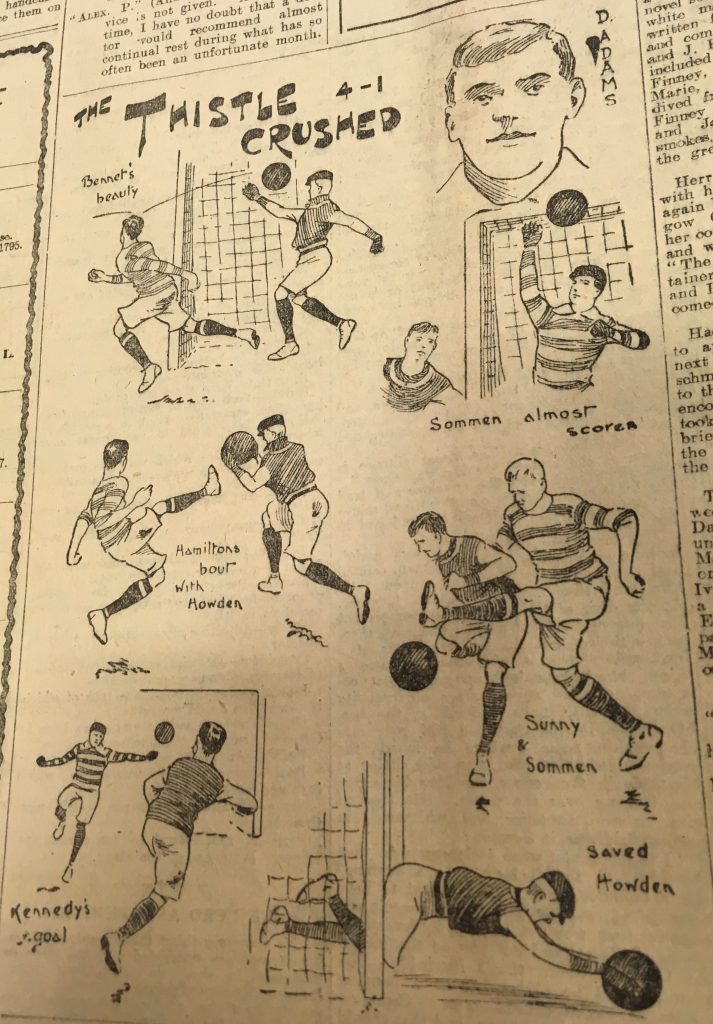
Celtic v Partick Thistle from 1906. Image from the Scottish Weekly Record.
It had been seven years Thistle were drawn at home in the first round of the Scottish Cup (Irvine in 1899) so it was no surprise when the draw required Thistle to travel again.
Thistle were paired with Leith FC, and the home team quickly expanded the terracing capacity of their Logie Green ground to accommodate the expected big crowd – upto 3000 Thistle fans were rumoured to be ready to travel through. The pitch, however, was much smaller than Thistle were used to. Leith were at the top of the Second Division and were current holders of the Qualifying Cup, and Thistle found the tie difficult. Indeed Leith might have deserved a draw but Thistle were just the better team, and won 1-0. The Edinburgh Evening News were disappointed in some of the pragmatic tactics adopted by the visitors of keeping the ball away from their goal by kicking it off the pitch: “Partick Thistle just about strained the patience of the referee in kicking out, but unfortunately the trick is too well known and indulged in, so that however objectionable was this feature of the visitors’ play, the possibility if the positions were reversed the same order of things would have prevailed.”
The second round saw another away draw – it had been five years since Thistle had been first out of the draw in any round of the cup. This time it was another journey to the capital, to play Hibs.
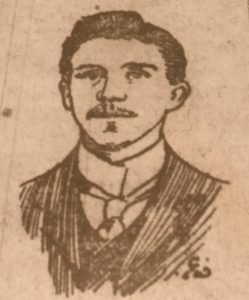
Carrick Hamilton
First, though, was a home league game against Hearts. The visitors were second in the league, the only team who could realistically catch Celtic at the top of the division. Carrick Hamilton returned to the side for his first game in a month, wearing a bandage to protect the wrist he broke against Motherwell on New Year’s Day. Thistle adapted the poor pitch conditions by playing a running and long passing game rather than using short passes, and won the game comfortably 4-1. The Scottish Weekly Record reported that Sam Kennedy had scored twice and restored himself as a favourite, having been in danger of being dropped. This seems unfair on Sam who had also scored in the last four games.
That result brought some doubt to the Edinburgh Evening News who had been ready to dismiss Thistle’s chances of beating Hibs.
“Partick Thistle are little better than second raters. For weeks together at the beginning of the year their best performance was to scrape through at home to Kilmarnock, yet there is dubiety at Easter Road as to the prospect of the Hibernians with home advantage pulling through, and all because of a Heart of Midlothian “rout” at Partick last Saturday. Partick Thistle possess a good and oft-times lucky defence, their goalkeeper combining pluck with ability. Otherwise they do not possess many claims to the first-class. Their best qualification is ability to go ahead and upset better teams by bustling tactics. It remains to be seen whether a better playing team in the Hibernians will allow themselves to beaten by these tactics.”
There was clearly an element of parochiality in play from the Edinburgh paper, as Thistle were four places and nine points ahead of Hibs in the League at the time. The previous year the two teams had met in the Cup, and Thistle eventually won through after a replay.
This year’s game also ended in a draw, Sam Kennedy scoring in a 1-1 draw, although both teams had plenty of chances to score more. Willie Howden and George Gilchrist were the pick of the Thistle players as the Evening News again accused Thistle of time wasting.
The same 22 players played the replay at Meadowside the following week. Harry Rennie of Hibs was the busier goalie but Thistle could only manage a single goal again, from James Sommen, who was Thistle’s best forward, contributing tricky runs and accurate crosses as well as his goal. It was a bit of a rough game, and some players were lucky to escape punishment. Thistle should have won, but Hibs equalised with just five minutes left to take the game to a second replay.
It had been a bumper crowd at Meadowside, and at Easter Road in the first game. In fact, the 20,000 crowd was the biggest attendance recorded at Meadowside, and also established a new record for gate takings – £483: previously it had been £415 v Hibs in the cup game the previous year.
The draws had been lucrative for the clubs’ bank managers. £731 had been shared over the first two games and it seemed likely that figure would rise to £1000 after the second replay. Hibs had offered Thistle half of the gate to play the game at Easter Road but Thistle refused. Hibs then offered half of the gate if the game could be played at Tynecastle, but Thistle didn’t want to play in Edinburgh again. Eventually the clubs agreed to play the replay at Ibrox and share the gate, hoping for a big Glasgow crowd. However, the game was up against the top League game of the day – Celtic v Hearts.
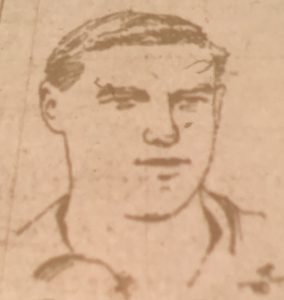
Bobby Gray
It was a game of penalties. Hibs scored one while Thistle missed two. Bobby Gray scored one goal but Hibs scored two, and Thistle were out of the Scottish Cup. The crowd was a disappointing 10,000 compared to 50,000 at Celtic Park.
Cup hopes were ended but there was still plenty to play for in the league. With seven games to play Thistle already had won more points than ever before. Games had been postponed for the Cup, allowing others to pull ahead, but Thistle still had aspirations to finish second in the league, behind Celtic who were well ahead of everybody else. It was a tough objective, and perhaps unrealistic. Hearts were in second and twelve points ahead with three games to play. Thistle still had seven games to play (six at home) so would need to win every game and hope that Hearts didn’t pick up wins.
The first game as won 1-0, an unremarkable win over Dundee. Thistle centre half David Melville and Dundee centre forward David Cowie had both been cautioned in the first half, and Melville was ordered off the pitch to receive treatment. In the second half Melville was sent off after an incident when Cowie’s nose was broken. Melville was suspended for a month – virtually all of the remaining league games.
The dream of second place ended abruptly the following week when Aberdeen won 2-1 at Meadowside. Aberdeen were in good form, having beaten Celtic the week before, but nonetheless were below Thistle in the table. Aberdeen goalie McFarlane performed heroics to keep his team in the game in one of the best matches seen at Meadowside all season.
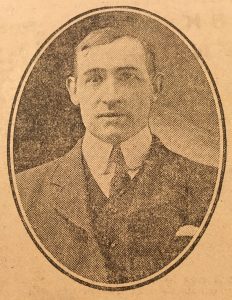
Willie Howden
There were still five league games to play, and the target of finishing in the highest league position to date was still realistic. Wins over Morton and Port Glasgow, and draws with Rangers and St Mirren lifted them to 5th position before last game of season. The draw with Rangers was the first point Thistle had taken from their neighbours in the League since the first game in 1897 (and the goals scored leaned heavily towards Rangers too – 11 for Thistle to 60). Willie Howden was injured against St Mirren but struggled on to play in the remaining league games.
A win in the last game, at Love Street, would have lifted the club to 3rd place, and Andy Swan gave Thistle an early lead. However St Mirren came back and won 2-1 after Willie Gray was forced to see out the second half injured.
Thistle ended the league season in 5th place and with the highest points total recorded by a Thistle team too. Willie Howden must have had a call to be the player of the year, having been responsible for the team taking points in several matches, although young John Lyon, who replaced the injured Tom Harvey in December and didn’t miss a game after that, would have run him close. The young full back was firmly a favourite with the Meadowside fans.
| Pos | Team | Pld | W | D | L | GF | GA | GD | Pts |
|---|---|---|---|---|---|---|---|---|---|
| 1 | Celtic | 30 | 24 | 1 | 5 | 76 | 19 | 57 | 49 |
| 2 | Heart of Midlothian | 30 | 18 | 7 | 5 | 64 | 27 | 37 | 41 |
| 3 | Airdrieonians | 30 | 15 | 8 | 7 | 53 | 21 | 22 | 38 |
| 4 | Rangers | 30 | 15 | 7 | 8 | 58 | 48 | 10 | 37 |
| 5 | Partick Thistle | 30 | 15 | 6 | 9 | 44 | 40 | 4 | 36 |
| 6 | Third Lanark | 30 | 16 | 2 | 12 | 62 | 38 | 24 | 34 |
| 7 | Dundee | 30 | 11 | 12 | 7 | 40 | 33 | 7 | 34 |
| 8 | St Mirren | 30 | 13 | 5 | 12 | 41 | 37 | 4 | 31 |
| 9 | Morton | 30 | 10 | 6 | 14 | 35 | 54 | -19 | 26 |
| 10 | Motherwell | 30 | 9 | 8 | 13 | 50 | 64 | -14 | 26 |
| 11 | Hibernian | 30 | 10 | 5 | 15 | 35 | 40 | -5 | 25 |
| 12 | Aberdeen | 30 | 8 | 8 | 14 | 37 | 49 | -12 | 24 |
| 13 | Falkirk | 30 | 9 | 5 | 16 | 53 | 69 | -16 | 23 |
| 14 | Port Glasgow Athletic | 30 | 6 | 8 | 16 | 38 | 68 | -30 | 20 |
| 14 | Kilmarnock | 30 | 8 | 4 | 18 | 46 | 68 | -22 | 20 |
| 14 | Queen’s Park | 30 | 5 | 4 | 21 | 41 | 88 | -47 | 14 |
Port Glasgow finished above Kilmarnock after a playoff.
The Glasgow League organisers had decided to experiment with midweek games rather than relying on finding free Saturday’s which had proved problematic in previous seasons, as the tournament was low on clubs’ priorities. The number of games had been reduced too, to just one game against each team, rather than one game at home and one away. Unfortunately, the first Thistle match (against Celtic in March) was postponed due to a frosty pitch, while the second (home to Clyde) was abandoned after it started late in front of a poor crowd. The midweek football experiment, as witnessed by other clubs too, wasn’t immediately successful.
Crowds were unimpressive – takings from the Thistle v Clyde game amounted to just £13. Unsurprisingly the competition didn’t take place the following season. Performances, too, were poor as trialists were given the opportunity to impress and earn contracts for the following season. Anderson Tennent, who had been playing as an amateur for Queen’s Park, guested for Thistle against Third Lanark and scored, earning him a place in the Thistle team for the next few seasons.
| Pos | Team | Pld | W | D | L | GF | GA | GD | Pts |
|---|---|---|---|---|---|---|---|---|---|
| 1 | Third Lanark | 5 | 4 | 0 | 1 | 5 | 1 | 4 | 8 |
| 2 | Rangers | 5 | 3 | 1 | 1 | 7 | 2 | 5 | 7 |
| 3 | Clyde | 5 | 2 | 1 | 2 | 4 | 5 | -1 | 5 |
| 4 | Celtic | 5 | 2 | 0 | 3 | 10 | 7 | 3 | 4 |
| 5 | Partick Thistle | 5 | 2 | 0 | 3 | 5 | 11 | -6 | 4 |
| 5 | Queen’s Park | 5 | 1 | 0 | 4 | 4 | 9 | -4 | 2 |
The biggest crowd ever witnessed in Scotland, 102,741, was recorded at Hampden in April, for the Scotland v England international. With no game, the Thistle players attended the game as spectators, and watched Scotland win 2-1. Liverpool’s Alex Raisbeck was man of the match, regarded as the best in Britain. Little would Willie Howden, Archie McKenzie and Sam Kennedy have realised that the big centre half would be their team mate at Thistle in a few years’ time.
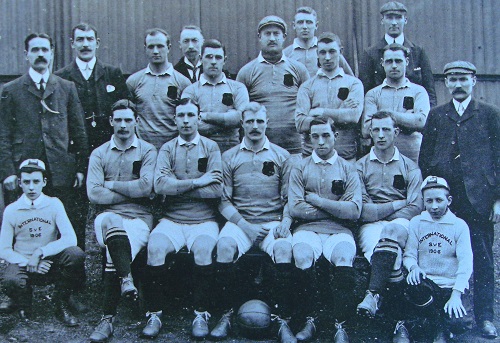
Alex Raisbeck in the centre of the front row, with the Scotland team against England.
Earlier in the season Thistle had been in demand to take part in benefit matches, and at the tail end it was the same. Thistle and Queen’s Park were approached to play a benefit match for West of Scotland Cricket Club, while George Gilchrist and Sam Kennedy played for a First Division team against a Second Division one in a benefit match for W.McMillan, the goalkeeper of Arthurlie, who died after an accident playing for Arthurlie v Leith in April.
David Melville was chosen to represent Glasgow against Sheffield in the annual fixture, played this year at Meadowside. The team comprised four Celtic players, three Third Lanark, and one each from Clyde, Queen’s Park, Rangers and Thistle. Glasgow won 1-0.
Despite the criticism of the pitch (it was often muddy and unplayable) and it’s location on the banks of the river Clyde (games were affected by sea fog) Thistle PT renewed the annual lease for Meadowside with the River Clyde Trustees for another year.
Players
August
Andy Swan, late of Tottenham Hotspur and St Mirren signed for Thistle.
William Brown, a junior from Newmilns, signed for Thistle
Archie McKenzie of Bo’ness signed for Thistle.
Carrick Hamilton, late of Queen’s Park, signed for Thistle.
Renton sign Wilson (a forward) from Thistle.
September
Thistle signed John Lyon from Clydebank Juniors. He can play either right or left back and is big and strong. From Ayrshire, he originally played for Irvine Meadow.
Adam McCall, a forward, was signed from Darvel
John Blackwood, the ex Thistle (from season 1899-00), Celtic and Portsmouth forward, played for Royal Albert.
H.Shand was signed from Inverness Thistle.
October
Inverness Thistle re-sign H.Shand from Thistle.
Thistle sign George McKinlay, the ex captain of Vale of Leven.
January
William Brown & Adam McCall were temporarily transferred to Ayr Parkhouse, then immediately back to Thistle.
George McKinlay was transferred back to Vale of Leven.
John Wilkie transferred from Hibs to Ayr Parkhouse. He had been suspended and transfer listed by Hibs in October.
February
Smith, the experienced PT and Vale of Leven back was transferred to Beith.
Crieff Morrisonians sign James MacGregor from Thistle.
March
William Brown was again transferred to and from Ayr Parkhouse, for the second time this season.
Munsey of Glenbuck, Wilson of Irvine Meadow and Robertson of Yoker played against Clyde in the abandoned Glasgow League match.
May
Andrews of Kirkintilloch Rob Roy was invited to play for Thistle.
Effingham Smith, the PT and Vale of Leven back who signed for Beith for the Scottish Cup ties, has signed for St Bernards.
Aitkenhead and Muir, the Maryhill forwards, played for Thistle against Clyde in the Glasgow League.
Carrick Hamilton (to Queen’s Park), Archie McKenzie (Bo’ness) and Adam McCall (Vale of Leven) were temporarily transferred to help other clubs.
Robert Campbell, who moved from Thistle to Rangers in 1905, signed for Bradford City.
Thistle signed P.G.McMillan from Dumbarton.
Andrew Swan has signed for Blackpool.
Sources and references
- Daily Record Aug – May
- Evening Times Aug – May
- Dundee Courier Aug – May
- Dundee Evening Telegraph Aug – May
- Edinburgh Evening News Aug – May
- Falkirk Herald Aug – May
- Berwickshire News and General Advertiser Aug – May
- Aberdeen Press and Journal Aug – May
- Scottish Weekly Record Aug – May
- Glasgow Evening News Aug – May
- Glasgow Weekly News Aug – Dec 1905.
- Athletic News Aug – May
- http://www.statto.com/
- http://www.londonhearts.com/
- http://partickthistleahistory.wikifoundry.com/
Categories
- Miscellaneous (16)
- Other clubs (15)
- Players (26)
- Thistle – early years (48)
- Thistle – general (5)
Football history links
- Ayr United archive
- Bill Shankly
- Falkirk Historian
- Gallant Pioneers – Early history of Rangers
- Glasgow Herald archive at Google
- Hibernian
- Hibernian Historical Trust
- London Hearts
- Partick Thistle history archive by StuTheJag
- Rangers History
- Scottish Football Historical Archive
- Scottish Football Museum
- Scottish Sports History
- ScottishLeague.net and forum
